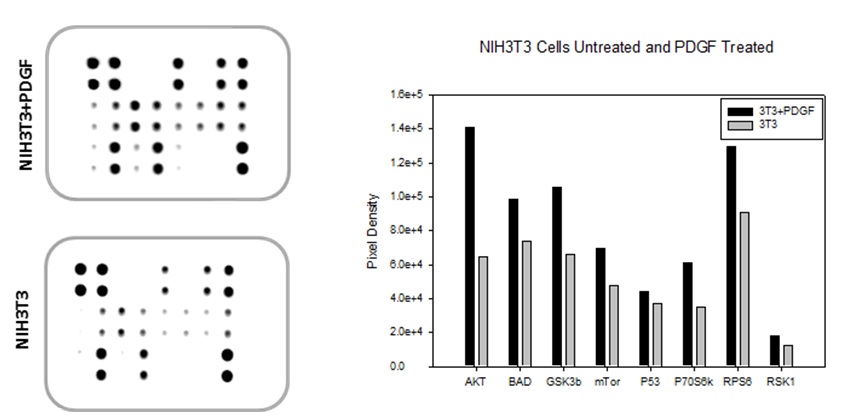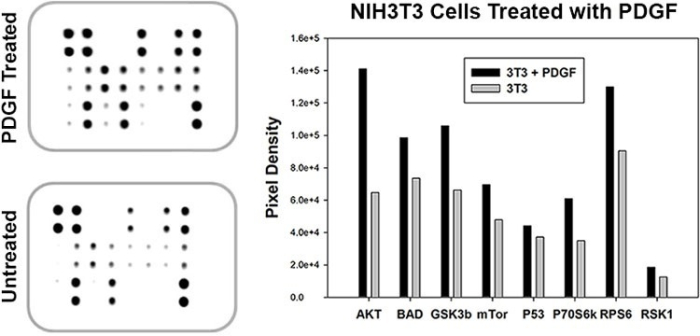Product Description
Specifications
| Size | 2 Sample Kit, 4 Sample Kit, 8 Sample Kit |
|---|---|
| Species | Human, Mouse |
| Quantitative/Semi-Quantitative | Semi-Quantitative |
| Number of Targets Detected | 18 |
| Compatible Sample Types | Cell Culture Supernatants, Plasma, Serum, Tissue Lysates, Cell Lysates |
| Solid Support | Membrane |
| Method Of Detection | Chemiluminescence |
| Design Principle | Sandwich-based |
| Research Area | Post-Translational Modifications, Phosphorylation, Akt Signaling, AMPK Signaling, HER/ErbB Signaling, HIF-1 alpha Signaling, IGF Signaling, JAK/STAT Signaling, MAPK Signaling, mTOR Signaling, PI3K-AKT Signaling, TGF-beta Signaling, Wnt/beta-Catenin Signaling |
| Estimated Lead Time | 1-2 business days |
| Shipping Type | Blue ice |
| Storage | -20°C |
Risk-Free Guarantee
We offer a 100% guarantee on all ELISA kits and membrane cytokine arrays.
Learn More
Amazon Gift Cards!
$5 Amazon gift card in every kit box purchased.
| Scroll over each target protein for more information | ||||
|---|---|---|---|---|
|
Akt (P-Ser473)
(PKB (P-Ser473))
|
AMPKa (P-Thr172)
|
BAD (P-Ser112)
|
4E-BP1 (P-Thr36)
|
ERK1 (P-T202/Y204)/ERK2 (P-Y185/Y187)
|
|
GSK3a (P-Ser21)
|
GSK3b (P-Ser9)
|
mTOR (P-Ser2448)
|
p27 (P-Thr198)
|
P53 (P-Ser15)
|
|
P70S6K (P-Thr421/Ser424)
|
PDK1 (P-Ser241)
|
PRAS40 (P-Thr246)
|
PTEN (P-Ser380)
|
Raf-1 (Ser301)
|
|
RPS6 (P-Ser235/Ser236)
|
RSK1 (P-Ser380)
|
RSK2 (P-Ser386)
|
||
Application Notes
- Human and Mouse AKT Pathway Phosphorylation Antibody Array C1 Membranes
- Blocking Buffer
- Detection Antibody Cocktail
- 1,000X HRP-Anti-Rabbit IgG Concentrate
- 20X Wash Buffer I Concentrate
- 20X Wash Buffer II Concentate
- 2X Cell Lysis Buffer Concentrate
- Detection Buffer C
- Detection Buffer D
- 8-Well Incubation Tray
- Protease Inhibitor Cocktail
- 100x Phosphatase Inhibitor Cocktail I
- Phosphatase Inhibitor Cocktail II
- Plastic Sheets
- Array Map Template
- Manual
- Pipettors, pipet tips and other common lab consumables
- Orbital shaker or oscillating rocker
- Tissue Paper, blotting paper or chromatography paper
- Adhesive tape or Saran Wrap
- Distilled or de-ionized water
- A chemiluminescent blot documentation system (such as UVP's ChemiDoc-It® or EpiChem II Benchtop Darkroom or GE's ImageQuant™ LAS 4000 or Amersham Imagers 600 and 680), X-ray Film and a suitable film processor, or another chemiluminescent detection system.
- Block membranes
- Incubate with Sample
- Incubate with Detection Antibody Cocktail
- Incubate with HRP-Conjugated anti-IgG
- Incubate with Detection Buffers
- Image with chemiluminescent imaging system
- Perform densitometry and analysis
Typical Data


Storage/Stability
Luszczak, S., Simpson, B.S., Stopka-Farooqui, U. et al. Co-targeting PIM and PI3K/mTOR using multikinase inhibitor AUM302 and a combination of AZD-1208 and BEZ235 in prostate cancer. Sci Rep 10, 14380 (2020). https://doi.org/10.1038/s41598-020-71263-9
Luszczak S, Simpson BS, Stopka-Farooqui U, Sathyadevan VK, Echeverria LMC, Kumar C, Costa H, Haider A, Freeman A, Jameson C, Ratynska M, Ben-Salha I, Sridhar A, Shaw G, Kelly JD, Pye H, Gately KA, Whitaker HC, Heavey S. Co-targeting PIM and PI3K/mTOR using multikinase inhibitor AUM302 and a combination of AZD-1208 and BEZ235 in prostate cancer. Sci Rep. 2020 Sep 1;10(1):14380. doi: 10.1038/s41598-020-71263-9. Erratum in: Sci Rep. 2020 Nov 11;10(1):19870. PMID: 32873828; PMCID: PMC7463239.
Chiurchiu V., Rapino C., Talamonti E., et al. Anandamide Suppresses Proinflammatory T Cell Responses In Vitro through Type-1 Cannabinoid Receptor-Mediated mTOR Inhibition in Human Keratinocytes. J Immunol. 2016 Nov 1;197(9):3545-3553. doi: 10.4049/jimmunol.1500546
Chiurchiù, Valerio, et al. "Anandamide suppresses proinflammatory T cell responses in vitro through type-1 cannabinoid receptor-mediated mTOR inhibition in human keratinocytes." The Journal of Immunology 197.9 (2016): 3545-3553.
Lu J, Liu QH, Wang F, et al. Exosomal miR-9 inhibits angiogenesis by targeting MDK and regulating PDK/AKT pathway in nasopharyngeal carcinoma. J Exp Clin Cancer Res. 2018;37(1):147. Published 2018 Jul 13. doi:10.1186/s13046-018-0814-3
Li M, Yang J, Zhang L, et al. A low-molecular-weight compound exerts anticancer activity against breast and lung cancers by disrupting EGFR/Eps8 complex formation. J Exp Clin Cancer Res. 2019;38(1):211. Published 2019 May 22. doi:10.1186/s13046-019-1207-y
Cai S, Yang Q, Cao Y, et al. PF4 antagonizes retinal neovascularization via inhibiting PRAS40 phosphorylation in a mouse model of oxygen-induced retinopathy. Biochim Biophys Acta Mol Basis Dis. 2020;1866(3):165604.
Qiao L, Hu S, Liu S, et al. microRNA-21-5p dysregulation in exosomes derived from heart failure patients impairs regenerative potential. J Clin Invest. 2019;129(6):2237-2250. Published 2019 Apr 29. doi:10.1172/JCI123135
Yang Y, Wang J, Guo S, et al. Non-lethal sonodynamic therapy facilitates the M1-to-M2 transition in advanced atherosclerotic plaques via activating the ROS-AMPK-mTORC1-autophagy pathway. Redox Biol. 2020;32:101501. doi:10.1016/j.redox.2020.101501
-
Great results, easy to useI bought this kit to test a theory about mtor activity in human intestinal stem cells. The kit was straightforward, easy to use, and gave great results. Analyzing the final images via Image J was a little tedious but it all worked out and helped highlight a new research target I hadn't previously considered!
on
Great productWorked fine as expected with minimal background. Great product when you have smaller sample size.from WUSTL,
on
Great productShipped promptly and consistent results! Highly recommend!from Cleveland Clinic,
on
Great productWe use this kit to test our AKT inhibitors in human cells. Although there seemed to have a background, overall it worked fine for us.on
Write Your Own Review
